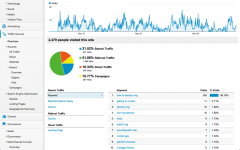 By James Crawford
By James Crawford
Why don’t PR folks understand what ‘conversion’ really means?
For too long, measurement has been the ‘elephant in the room’ of the PR industry.
Too many PR people simply can’t measure their work — and that’s not good.
Even in 2014, there are still people in the industry who use advertising equivalent value (AVE) as a measurement metric.
AVE has has been widely derided and there are much better metrics available.
In Europe, the Barcelona Principles effectively killed AVE, but people still hang onto it.
Don’t Be Afraid of Analytics
At PR Agency One, everyone gets their hands dirty with analytics.
It takes years of practice, so I encourage all members of staff to explore the agency’s Google Analytics account. It’s pretty difficult to break it, and all they lose is a bit of time. Some of them take to it like a duck to water, while others hate analytics.
It takes all sorts of personality types to run a PR business, so work with a coalition of the willing to make sure measurement works for you and your clients.
Beware the False Metrics
I often see PR practitioners who have tried to grasp digital metrics, only to get sucked in by vanity metrics.
Numbers of followers or ‘likes’ are often used to present the effectiveness of a digital campaign. This data might make pretty graphs and charts, but often bear no relation to a company’s bottom line.
When I read PR case studies or award submissions, I often see unique visits sent to a website listed as a conversion metric. While this is an important step forward, I feel this is a soft metric.
For example, I have sent tens of thousands of users to websites from sites such as Reddit, occasionally crashing clients’ sites. Despite sending so many unique users, there weren’t any conversions. For goals and conversions to be king, you need to be able to measure them.
Measuring Conversions and Goals
Google Analytics is a great place to start. Too many PR practitioners still can’t sign into the software, let alone place the tracking code on a website.
What really matters are conversions, such as goals you set (e.g inquiries) and orders placed.
Goals can be:
- How many people reach a designated page, such as an order confirmation page or contact form.
- How many people stay on a site for a specific amount of time.
- How many people who have viewed a specific number of pages on a website.
- How many people have triggered an event, like watching a video.
Conversions can also be tied to sales, and, for e-commerce sites, goals can link time on site with actual transactions.
If you do one thing today, go and read this post by analytics legend Justin Cutroni, about setting up Google Analytics for e-commerce.
When conversion metrics are set up correctly, we can begin to track and attribute activity.
We can start to look at where traffic came from, and determine if it correlates to PR activity.
We can look at what worked and what didn’t.
And we can determine how much revenue came directly from social media and search.
Conversions in the Real World
Don’t forget about dashboards, advanced segments, funnels, regular expression goals, first visit attribution, and a whole new world of big data. It’s enough to make your head spin. To be honest, I need help with some this.
I work with SEOs who are clearly more clued up on analytics than a PR man like me will ever be. Reach out to industry peers and trade knowledge and experience.
Often our clients exist in a multi-channel world where bricks and mortar retail stores are equally important.
The ability to overlay online data with real world sales figures helps to create a very powerful set of metrics. Forget about AVE, Klout scores, and “Like” acquisitions, and set up some real conversion-based metrics.